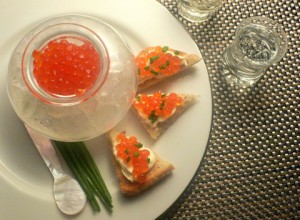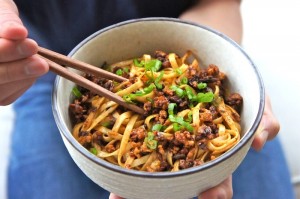Was it a French gourmand (or possibly just HG) who mused: “Dinner without an entree (appetizer) is like making love without foreplay” ? Yes, an appetizer is a good idea. But, it must be modest so as not to blunt ardor for the main event (okay, okay, that’s the end of the semi-naughty references). So, here are a few of HG’s favorite starters. Three chilled Colville Bay oysters on the half-shell. Spanish Piquillo peppers with a bit of fresh mozzarella/buratta drizzled in good olive oil and Maldon Smoked Sea Salt Flakes. A slice of Italian prosciutto with a ripe, fresh fig. A slice of Serrano ham on thin buttered bread. A dab of Alaskan salmon red caviar (best purchased online from Zabar’s) topped with creme fraiche on a buttered slice of lightly toasted Pepperidge Farm Thin White bread. A chunk of schmaltz herring (from Russ & Daughters) rolled in chopped onion and downed with a shot glass of icy vodka. Slice of smoked salmon (Nova Scotia or Scotland) with capers, olive oil and ground pepper. And, here’s a suggestion by HG for something you may not have tried: Cook a small bit of Angel Hair or Capellini pasta. Top it with a sauce made of olive oil, finely chopped raw garlic, a few sardines, a squeeze of tomato paste, coarse salt and plenty of ground black pepper. So good that you might be sorry you’re not having it as your main dish.
Savory Starters
February 27th, 2014 § 0 comments § permalink
Pasta Joys
February 26th, 2014 § 0 comments § permalink
It may seem like HG is referencing the Middle Ages, but back in the 1970s pasta was still a fairly exotic term while spaghetti ruled the roost when it came to Italian noodles dishes. The great wave of wonderful pasta dishes and their sauces had yet to arrive in the typical american pantry. In fact, HG first tasted penne with broccoli at Delsomma, a wonderful (alas, long closed) Italian restaurant on W. 47th Street in New York. (HG wrote about the restaurant: Gone But Not Forgotten Restaurants: Delsomma…Sept. 2011). Loved the dish and it became a mainstay in the HG/BSK home. BSK makes the broccoli sauce this way: Blanches florets and stems in the boiling pasta water. Purees some of the broccoli in the blender with chicken stock. Sautes the rest of the broccoli in olive oil with anchovies and minced garlic. It’s all blended with parmesan and poured over the pasta with a dusting of red pepper flakes and chopped parsley. Mighty good. Giuliano Bugialli, the esteemed Italian pasta authority, suggests another way to make penne with broccoli, a method popular in southern Italy. The broccoli is cooked with the pasta. First, the stems are added to the boiling pasta. After two minutes, the florets go into the pot. in 12 to 15 minutes the pasta is al dente and the broccoli is cooked. Minced garlic, red pepper flakes and capers are heated in olive oil and poured over the broccoli and pasta. Showered with chopped parsley. HG will try this method but will add anchovies, an ingredient that complements the sponge-like nature of a broccoli floret.
While it may seem difficult to find a new method to making pasta, BSK did just that a few days ago: Cauliflower-bacon-penne risotto. That’s right. Risotto made with penne pasta instead of rice. BSK roasted cauliflower florets with a dusting of cumin. Fried thick cut bacon to crispness. Deglazed the bacon pan, sauteed some garlic and added the bacon and roasted cauliflower. Cooked the penne like Arborio rice. In a heavy saucepan, cooked sliced onion in olive oil until transparent. Mixed the softened onions with penne. Added chicken stock. Tossed in a tablespoon of dry white wine. Brought liquid to a boil. Reduced to medium high and then simmered. HG stirred the mixture until the penne had absorbed the flavorful broth and was al dente. HG made sure some starchy broth remained to make a sauce. In went the cauliflower-bacon with Romano cheese, Maldon Smoked Sea Salt Flakes and ground pepper. A perfect dish wish a green salad and red wine. Pasta still has many joys.
Angelina’s
February 24th, 2014 § 0 comments § permalink
Espanola, a gritty town ten minutes drive from HG/BSK’s Jacona home, is much maligned. It has some social problems (it is known as New Mexico’s meth capital); a political system that is often criticized; much unattractive housing and numerous shopping centers built without an iota of soul or aesthetic foresight. Offsetting this is colorful, vernacular architecture (featuring some wonderful neon signage), a surprising amount of cutting-edge modernism and numerous good places to eat. Foremost among them is Angelina’s, a spacious place that draws a colorful crowd of New Mexicans–young, old, ranchers, cowboys, farmers, government officials, businesspersons. The food is solid Northern New Mexico. Red chile sauce is a specialty but the green is not far behind (on a recent visit, HG had a bowl of super assertive green chile menudo that chased away the chills and any lingering effects of a previous night’s overindulgence in alcohol). During the meal, HG/BSK shared some robust ground lamb burritos (the lamb had been grilled with pico de gallo and melded New Mexican and Middle Eastern flavors). Lamb is a specialty of Angelina’s (sheep have been raised in Northern New Mexico for many generations). At Angelina’s, you can have lamb in many forms. There are lamb burgers (plain or grilled with jalapenos and onions); lamb chops; lamb ribs (Costillas) and lamb fajitas. And, you can specify lamb in any of the traditional plates like enchiladas, flautas, tostadas, etc. for a $1.00 additional charge. Besides the lamb dishes, Angelina’s has another unusual twist. The restaurant serves traditional, down home diner favorites: Deep fried breaded catfish; pork chops; liver and onions; chicken fried steak. You can also get a big, ribeye steak; salmon, trout and shrimp. There’s wine (not exactly a Parisian carte de vins) and beer. Very nice flan for dessert. Yes, Angelina’s does it all. Big portions. Small prices. Lots of plain spoken comfort.
Li’l Abner
February 23rd, 2014 § 0 comments § permalink
Last night, BSK placed a platter of delectable adobo dusted pork chops on the table and anoounced: “P’ok chops.” HG replied: “Thanks, Daisy Mae.” Older followers of Hungry Gerald know this was a reference to Li’l Abner, the immensely popular and influential comic strip created by Al Capp (1909-1979). Since the strip ceased publication in 1977 after a 43-year run, younger folks might not be familiar. L’il Abner was set in the impoverished mountain town of Dogpatch, Arkansas. L’il Abner, a strapping and guileless youth, was a member of the Yokum family of hillbillies. Daisy Mae Scraggs, a shapely lass in flimsy clothing, tried (to no avail) to marry Abner. The innocent lad was oblivious. His major interest was his favorite dish: “P’ok chops.” The strip featured numerous imaginatively named characters: “Moonbeam McSwine”–a gorgeous girl who liked to loll about with pigs; “Evil Eye Fleegle”–a zoot suited New Yorker capable of giving adversaries the “whammy”; “Senator Phogbound”–a Dixiecrat windbag; “Stupefyin’ Jones” –a woman so beautiful she reduced men to instant paralysis after one glimpse; “J. Roaringham Fatback”–the quintessential greedy capitalist; “The Scraggs”—Daisy Mae’s terrible (shudder) relatives who lived in Skunk Hollow; “Joe Bftplsk” –the unlucky guy who lived under a perpetual black cloud. One of Capp’s inventions was the Shmoos, loveable, ham shaped creatures who fulfilled all food needs: They produced excellent milk and butter; when roasted or baked they tasted like ham or pork; when fried, they tasted like chicken; when broiled, they tasted like steak. Capp’s characters became part of the American language and folklore. He even spawned an event: Sadie Hawkins Day. Two examples of Li’l Abner influence: An unattractive neighborhood in Fire Island, the lovely barrier beach off New York’s Long Island, is known to the present day as “Skunk Hollow.” BSK spent a number of years guiding the public/media/government/community relations of developer Greg Stevinson as he successfully built a vast, diversified retail-office-residential community on a large family land holding — sneeringly dubbed “Dogpatch” before BSK came along and worked her magic. At its height, the Li’l Abner strip reached 60,000,000 Americans in 900 newspapers and appeared in 100 foreign periodicals in 28 countries. It spawned a movie and a Broadway musical (Julie Newmar played Stupefyin’ Jones and became a star without saying a word). John Updike called the character, Li’l Abner, “a modern Candide” and John Steinbeck suggested Al Capp for a Nobel Prize in Literature. HG is sorry the strip no longer exists. The hedge funders, oligarchs, sexist bigots and nay saying-Republicans could use a blast of Capp’s withering satirical wit.
Celery
February 22nd, 2014 § 0 comments § permalink
Celery is a modest vegetable. More a character actor than a main star. Essential base ingredient for making all sorts of stocks and sauce; deeply reliable for adding texture and subtle flavors to salads (green, tuna, chicken, etc.). Otherwise invisible. This was not always the case. In HG’s youth, celery stalks and olives were always served at formal dinners as part of a crudité and often were a giveaway at good restaurants. Best celery dish ever was braised celery with bone marrow, a specialty at the Oak Room in New York’s Plaza Hotel. (Last time HG ate this was at lunch with the late Ron Ziegler, Nixon’s press secretary. Ziegler scarfed down one order of this luscious dish and quickly ordered another which he also managed to finish) and promptly hired HG for a lucrative PR assignment. Nothing to do with Nixon, HG adds ). Celery made a bit of a comeback when Buffalo chicken wings became fashionable. The favored accompaniment for those peppery hot morsels was celery stalks with blue cheese dressing. Celery has an affinity for blue veined cheese. The English often serve lush Stilton with celery. HG likes celery stuffed with good Maytag Blue or Stilton and a glass of port. Give it a try. The imperative is to get rid of the stringy exterior of celery stalks with a vegetable peeler. There is one place where celery–both cooked and raw–is consumed with gusto: Tuscany. Tuscans have even invented a pasta called sedanini, which translates as “small celery pieces.” There are two basic Tuscan pasta recipes that utilize celery: Sedanini al Sedano (celery is boiled until fully cooked but still firm and then mixed with garlic that has been sizzled in olive oil, red pepper flakes, salt, pepper and some of the water the celery has been boiled in) and Sedanini alla Crudaiola (a warm weather dish where the celery is mixed with peeled and marinated ripe tomatoes; garlic, basil, parsley, olive oil and red pepper flakes). Giuliano Bugialli, the Italian pasta authority, says the key to both dishes is to cut the celery into pieces that are the same shape and size as the “sedanini” pasta. Sounds good. Time for celery to make a comeback.
Peanut Butter A La Chinois
February 21st, 2014 § 0 comments § permalink
Yes, HG has never outgrown the pleasure of peanut butter and jelly. However, HG has found other splendid uses for peanut butter. One is a Chinese concoction that’s great as a sauce for linguine or spaghettini, chicken or a combo of chicken and pasta. It’s the sauce for the popular hot and spicy dish–Dan Dan Noodles. HG is not going to give you exact proportions for the sauce. Figure it out. Make it your own. Here are the ingredients: smooth organic peanut butter, sesame oil, peanut oil, soy sauce, rice vinegar, chopped Szechuan preserved vegetables, finely chopped garlic, hot sauce (Sriracha, Thai, Indonesian or other); chopped scallions. Try it with the pasta alone (room temperature or slightly chilled). Poach some chicken, get rid of the skin and bones, shred and mix with the pasta. Or, have the sauced chicken alone with scallions and romaine lettuce (which you can use as a wrap). Also nice as a topping for a crisp, room temperature sauteed skinless chicken breast paillard. Warning: This peanut butter sauce is addictive.
Goldfinger: Man and Movie
February 19th, 2014 § 0 comments § permalink
During HG’s many years as a public relations expert HG interacted with many important architects and interior designers (HG has particularly pleasant memories of the renowned architect Mies van der Rohe and the interior designer Jay Spectre — both deceased). HG has continued to be interested in architecture and design. Some 300 books on these subjects (as well as 30-years worth of World of Interiors magazine) adorn (or clutter) HG/BSK’s shelves. Viewing the latest James Bond extravaganza (HG misses Sean Connery), HG thought of previous Bond films, specifically Goldfinger. HG began humming the memorable theme song of the film and this led HG’s thoughts to Erno Goldfinger, the emigre architect who played an important role in bringing modernist architecture to Britain. Goldfinger designed and built 1-3 Willow Road, a group of very modern terraced houses adjacent to London’s Hampstead Heath. Goldfinger occupied one of these houses. They replaced some old cottages. This aroused the anger of Ian Fleming, writer of the James Bond novels. Some violent verbal battling between Fleming and Goldfinger. Fleming’s revenge was to name his gold-obsessed villain after Goldfinger (Fleming wanted to call his villain “Goldprick” but was talked out of it). Erno Goldfinger was continually maddened by telephone callers humming the “Goldfinger” movie theme. One of the other Willow Road houses (beautiful, clean lined interiors) was occupied by HG’s friend, the multi-talented Bob Judd, auto racing novelist (he is to auto racing what Dick Francis is to horse racing); poet; former ad executive. In his Goldfinger-designed kitchen, Bob once served HG/BSk a dinner of a poached Irish salmon with fennel braised in chicken broth and much butter. Memorable.
Oyster Pancake A La Exquisite Maiko
February 16th, 2014 § 0 comments § permalink
Whole Foods is now carrying containers of shucked East Coast oysters (better than those big, tasteless oysters from the Pacific). Provided the impetus for a nice light dinner of Japanese oyster pancakes (Okonomiyaki) . EM, HG/BSK’s lovely Japanese daughter-in-law, is a talented chef and caterer. Efforts to emulate her cuisine often fall short, but the flavors are so great that it is still worthwhile to try. BSK followed EM’s recipe and made a batter of egg, Wondra flour and milk. Mixed it with slivers of cabbage, scallions, carrots and plenty of chopped oysters. Turned out splendidly. Crisp, lacy, greaseless pancakes with plenty of sea flavor and crunch. BSK likes these pancakes with a squirt of Japanese Bull Dog Sauce, a semi- sweet condiment. HG sticks to a light dusting of truffle salt and a squeeze of lemon. Thank you, Maiko.
William Zeckendorf, Jr.
February 15th, 2014 § 2 comments § permalink
William Zeckendorf, Jr., real estate developer and philanthropist, died recently in Santa Fe. Born in New York, son of the legendary, flamboyant developer William Zeckendorf, Sr., Bill was a quiet, cerebral version of his father. But, like his father, he took big financial risks resulting in major ups and downs. The sons of Bill, Jr. are real estate titans in New York these days, developing and selling condominiums at astronomical prices (they recently sold a $40,000,000 condo in a building they developed on Central Park West). Bill, Jr. hired HG (late 70’s or early 80’s in HG’s memory) to thwart community opposition and publicize a risky development–a 33-story condominium tower on the northwest corner of 96th Street and Broadway called The Columbia. Lots of development plans for the site had failed. This was before the West Side became a fashionable address for the upwardly mobile and Broadway still contained many nocturnal hookers and quite a few outdoor drug markets. HG met with officials of the local elementary schools and worked out an arts program for the construction fence of the condo. Sixth and seventh grade students used the fence as a revolving art show painting pictures on themes like “My dream home”, “Favorite New York building,” “My hero,” etc. HG organized a jury of community luminaries (including some anti-development firebrands) and prizes were awarded monthly for best efforts. It all received loads of publicity and TV coverage and focused attention on the development as a family friendly and community involved environment. The condos sold quickly and Bill, Jr. went on to do major developments on Union Square, Eighth Avenue and other locations until getting whacked by financing disasters. HG always enjoyed his New York business meetings with Bill, Jr. They took place at the Sparks Steak House. Bill, Jr. thought the steak house had the best wine list in town and introduced HG to many splendid vintages. HG has delicious taste memories of cabernet from the Jordan winery in California. Bill, Jr. was a member of the distinguished wine lovers association, Confrerie des Chevaliers du Testavin. He inherited his wine love from his father. William Zeckendorf, Sr. headed the Webb & Knapp real estate firm with headquarters on midtown Madison Avenue. Its conference room was a circular space on the top floor of the building. That’s where William, Sr. hosted his legendary business lunches. HG was present at one (in 1962 or 1963, a few years before Webb & Knapp went bankrupt in 1965). HG was present because HG had been hired to do a publicity project for Mile High Center, a W & K development in Denver. As usual, a superb French wine was served at lunch (by a quite formal butler). The majority of the luncheon guests were concerned bankers and others who were owed a great deal of money by Zeckendorf. One of the bankers sipped his wine. “Say, Bill, this is great wine. How much would a bottle of this good stuff cost?” Zeckendorf stated the price. The banker blanched. The others at the table looked shocked. Yes, William Zeckendorf may have been going bankrupt but he never lowered his wine drinking standards.
No Tip Trotsky
February 14th, 2014 § 0 comments § permalink
Last week, a philosophical HG posted his thoughts about defeat and the Denver Broncos Super Bowl debacle. HG quoted the Russian revolutionary Leon Trotsky’s remark about defeated adversaries and “the dustbin of history.” BSK, the love of HG’s life, said: “I am sure you are the only person in the United States who linked Leon Trotsky with Peyton Manning.” Made HG think about some Trotsky connections. HG’s acquaintance and dining companion, Bernard Wolfe, the late novelist and science fiction writer, was Trotsky’s secretary-bodyguard in 1937, some three years before Trotsky was assassinated in Mexico City by Ramon Mercader, a pick axe wielding Stalin agent. Wolfe wrote an interesting novel about Trotsky’s Mexico City exile: The Great Prince Died. In the novel, Victor Rostov (the Trotsky character) expresses regrets about some of his murderous acts following the Bolshevik rise to power. (HG believes the real life Trotsky was devoid of what he would term “bourgeouis sentimentalities.”). During a three month period in 1917, Trotsky lived on Vyse Avenue in the East Bronx, a few blocks away from where HG’s parents lived with their two year old son, Bernard (HG didn’t come along until 1929, an unwelcome surprise for his Mom). HG’s father saw Trotsky dining in a neighborhood restaurant. A waiter told him that Trotsky would not leave a tip. Claimed it would demean the waiter, a member of the proletariat, and turn him into a lackey. Trotsky was not a favorite of the restaurant staff. When HG was a youngster, HG and his father paused to listen to soap box (when was the last time you saw a soap box?) orators in Union Square Park. A fiery Yiddish speaker called Trotsky: “Ah mench mit ah goldeneh kup.” (A man with a golden head). HG’s father, a confirmed David Dubinsky/ILGWU/ labor union socialist, despised Trotsky and all communists. Remembering Trotsky’s murder, he said: “Trotsky was lucky a Bronx waiter didn’t stick a fork in his golden head.”









